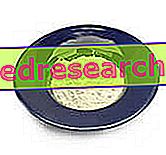What are
What are noodles?
Noodles are a long pasta format obtained by shaping an unleavened mixture of flour and water.

The various types of flour can have very different chemical and physical characteristics; therefore, when talking about noodles, it is necessary to specify the composition of the raw materials or the geocultural origin.
Noodles belong to the III fundamental group of foods - foods rich in complex carbohydrates and fiber - and are edible only after cooked. They are a basic food for many eastern cultures and especially for China - the country of origin. Their relevance in the diet can vary depending on the type of noodles in question. Some are quite caloric, rich in carbohydrates, containing gluten, etc. Others, on the other hand, have a very high percentage of protein. A third category brings significant levels of soluble fiber and is poorly energetic.
deepening
For basic foods - or basic foods - means all those foods which, for one or more populations, constitute the primary nutritional source of sustenance - necessary for survival or in any case deeply rooted in the local food culture.
The concept of "noodles" can change significantly depending on the local context and culture. In some countries this word is used as a true synonym of long pasta; to an inexperienced eye, noodles can actually resemble many typical Italian products.
The process of preparing noodles is quite similar to that of our fresh pasta. Flour and water are added to form a dough that will be extruded, rolled and sliced. These foods are therefore not necessarily cylindrical and, if made by hand, they can look a lot like our noodles. Other common forms of noodles are: helix, tube - like bucatini - etc.
The cooking of noodles varies depending on the type. The traditional ones, based on wheat flour, are dipped in boiling water, drained, sautéed and fried. Unlike Italian spaghetti, noodles are served more frequently with dry accompaniments, without tying the sauce, or immersed in soups. Fresh and raw, they can be kept shortly with refrigeration only; alternatively, to prolong the healthiness period, they are dried.
Curiosity
Strangely, the term "noodles" has not oriental roots but German, from "nudel".
Nutritional Properties
Nutritional properties of noodles
WARNING! As we have already specified, that of noodles is a real group of foods that contains many products that are also extremely different from each other. It is therefore impossible to establish a single nutritional description that includes them all; therefore, the one that will follow will refer to the more traditional and widespread noodles, or those based on wheat flour or rice or buckwheat and water.
Noodles belong to the III fundamental group of foods - foods rich in starch, fiber and some specific minerals and vitamins. Depending on the state of hydration, raw can have a medium or high caloric intake - dry ones are more energetic, while fresh ones are much less. Note : this difference is actually irrelevant, since all cooked noodles - with the same ingredients - indifferently whether dry or fresh, reach the same percentage of water and the same calories.
Energy is supplied mainly by carbohydrates, followed by proteins and finally by a small amount of lipids. Carbohydrates are mainly complex, peptides of medium biological value - that is, they do not contain all the essential amino acids compared to the human protein model - and unsaturated fatty acids. Cholesterol is absent; the fibers are significant.
Noodles are lactose free but, if made from wheat flour or similar, they contain gluten - those made from rice, soy, buckwheat or other ingredients (such as algae) instead, they do not. They do not have a relevant level of amino acid phenylalanine and uric acid.
As far as vitamins are concerned, some water-soluble of group B such as thiamine (B1) and niacin (vit PP) are quite relevant; the liposoluble instead, do not appear to an appreciable extent. With regard to mineral salts, phosphorus, potassium and magnesium levels can be considered useful - but not particularly relevant.
Did you know that ...
Soy noodles - which are also very common - compared to those made from cereal flour or pseudocereals, are richer in lipids - even polyunsaturated ones - and proteins with a better biological value. They also bring lecithins, phytosterols and fat-soluble vitamins. They are gluten-free.
Diet
Noodles in the diet
Noodles lend themselves to most diets. Nevertheless, those based on starch flour - due to the relevant glycemic load and significant caloric intake - would be used sparingly in the case of overweight, type 2 diabetes mellitus and hypertriglyceridemia. Note : however, it would be reasonable to evaluate the accompanying sauce, which is often characterized by abundant amounts of fat. By themselves they have no negative implications for hypercholesterolemia and primary arterial hypertension.
Containing fibers, the noodles participate in keeping the large intestine healthy. They participate in preventing or treating constipation, in turn involved in the onset of diseases such as: diverticulosis, diverticulitis, haemorrhoids, anal fissures, anal prolapse etc. Furthermore, soluble fibers have a marked prebiotic function; nourishing the intestinal biological flora further contribute to keeping the cells healthy from the large intestine.
Wheat-based noodles do not lend themselves to the celiac diet. Soy, seaweed, rice and many others have no contraindications. They can be included in the nutritional regime of lactose intolerant, phenylketonuria and hyperuricemia.
They are a modest source of B vitamins, which essentially play the role of coenzymes in cellular processes. They also contain moderate amounts of certain minerals of which, however, with the exception of magnesium, the body hardly goes into deficiency - these are almost ubiquitous macro elements in food, in particular phosphorus and potassium.
Noodles lend themselves to vegetarian, vegan - non-raw food - and religious diets of any kind. The medium portion of fresh noodles, taking for granted an accompanying sauce of medium caloric value, is about 120 g; that of dried noodles instead, corresponds to about 80 g.
History
Historical notes on noodles
The origin of the noodles is Chinese. The first written trace is in a book dating back to the Eastern Han period (25-220 AD). Made from wheat flour and water, they had become a staple food for the people of the aforementioned dynasty.
An article in "Nature" has argued that the oldest evidence of noodle consumption dates back 4, 000 years to China. In 2005, a group of archaeologists discovered an earthenware bowl that contained 4, 000-year-old spaghetti in the Lajia archaeological site. It seems that these resemble the "lamian", a type of Chinese noodles produced by repeatedly pulling and ironing the dough by hand. It was determined that these spaghetti were millet based, identified as belonging to the " Panicum miliaceum " and to the " Setaria italica ". However, observing the millet pasta production process, other researchers have established that it would not be possible to extend it as much as necessary - due to the absence of gluten - denying the hypothesis and criticizing the sampling method.
Types
Types of noodles
There are various types of noodles that differ not only in the basic ingredient, but also in the processing. Let's see the main ones:
- Wheat noodles:
- Bakmi: Indonesian Chinese yellow wheat topped with eggs and usually chicken meat
- Chūka men: Japanese word for "Chinese spaghetti", used for ramen, champon and yakisoba
- Kesme: similar to wheat noodles originating in central Asia, flat, yellow or reddish brown
- Kalguksu: knife-cut Korean noodles
- Lamian: hand-drawn Chinese noodles
- Mee pok: Chinese, yellow noodles, popular in Southeast Asia
- Reshte: flat Central Asian pasta, very pale (almost white) color used in Persian and Afghan cuisine
- Sōmen: thin variety of Japanese wheat noodles, often covered with vegetable oil
- Thukpa: Tibetan noodles
- Udon: thicker variety of Japanese wheat noodles.
- Rice Noodles:
- Bánh phở: Vietnamese name of Chinese rice noodles
- Hé fěn o ho fun o kway teow or sen yai
- Mǐfěn or ape or sen mee
- Idiyappam: Indian noodles
- Mixian and migan: south-west of China
- Khanom Chin: fermented rice paste used in Thai cuisine.
- Buckwheat Noodles:
- Makguksu: local specialty of the province of Gangwon in South Korea
- Soba: Japanese buckwheat noodles
- Memil naengmyeon: Korean buckwheat noodles, slightly more chewy than soba.
- Other noodles:
- Acorn noodles: also called guksu dowries in Korean, they are made of acorn flour, wheat flour, wheat germ and salt
- Olchaeng-chi guksu: corn soup passed directly into cold water. They are Korean and typical of the Gangwon-do
- Cellophane noodles: they are made from mung or potato starch or cane starch or various starches of the same kind
- Chilk naengmyeon: Koreans, made of kudzu root starch, known as kuzuko in Japanese, gummy and semitransparent
- Shirataki noodles: Japanese, made of konjac (devil's language)
- Kelp noodles: based on algae.
Kitchen
Famous noodle recipes
- Stir-fried noodles using the wok
- Basic noodles: they are cooked in water or in broth, then drained and possibly sautéed with sauce or fried
- Cold noodles: boiled and served cold, sometimes in salads. Examples include Thai noodles salad and cold udon
- Fried noodles: stir-fried pasta with meat, fish, vegetables and dairy products. Typical examples include: chow mein, mein, mie goreng, hokkien mee, some varieties of pancit, yakisoba, curry noodles and pad thai.
- Spaghetti soup: noodles served in broth. Typical examples are: phở, beef noodle soup, chicken noodle soup, ramen, laksa, saimin and batchoy.



